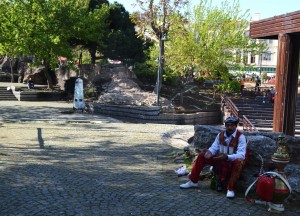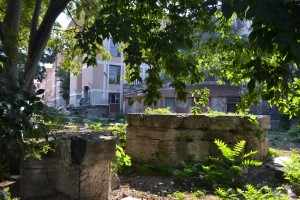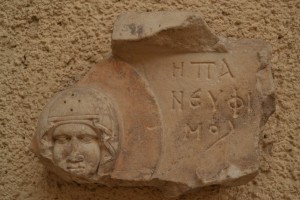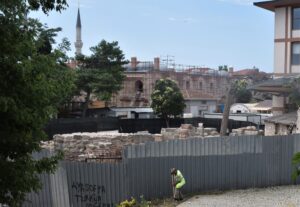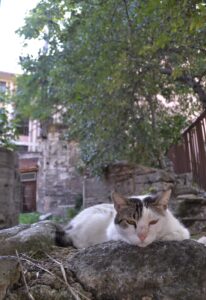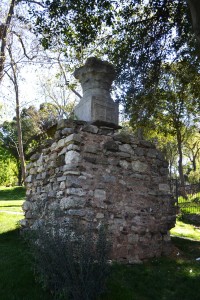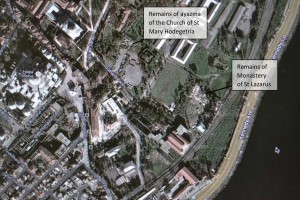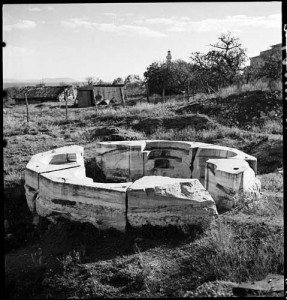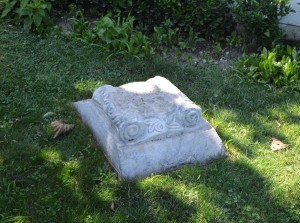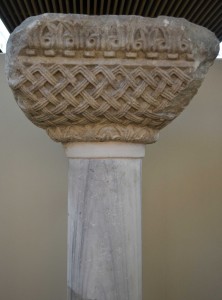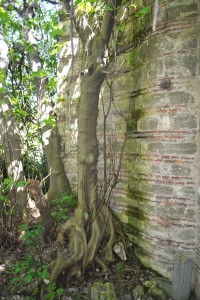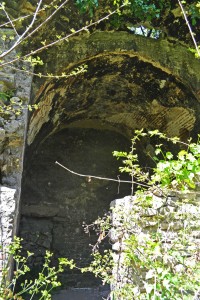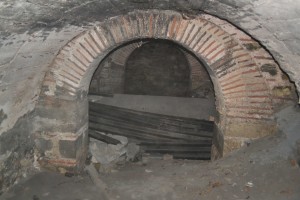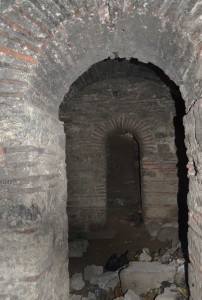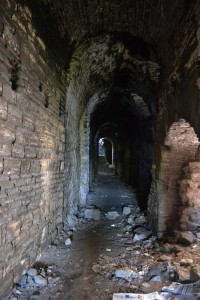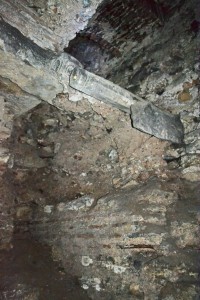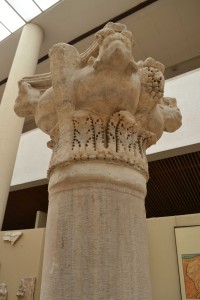The centre of Sultanahmet. (48.00771,28.974767).
The ruins of the Martyrium of St Euphemia provide convenient seats and hiding places for eccentrics and cats. It must have been a massive, solid structure once. It was built in the early fifth century to provide an appropriately respectable resting place for the body of St Euphemia, a virgin, as seems to have been a prerequisite for a female to become a martyr. There are apparently some frescoes in the ugly little shed leaning against the law courts. I have never been able to get in to see them.
The photo above shows the situation in July 2019.
An idea of what used to be in this area can be gained from a look at Nicholas Artamonoff’s photographs from around the late 1930s, on the Dumbarton Oaks site.

Posted June 19, 2014 Posted by Adam in Uncategorized
Near the so-called Goth’s Column in Gülhane Park are some Byzantine remains, decorated by columns assembled from pieces found in the area (41.015114,28.985415). There are records of three possible structures in the region: The Orphanage of St Paul and the churches of St Demetrios and St Menas. The pieces in these photos are probably from the orphanage. The area is lovely in spring when it is an ocean of tulips in a part of the park that is relatively sparsely populated.
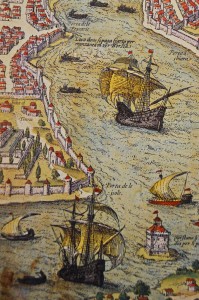
The three churches at the point of Saray Burnu, from a plan of Constantinople by Giovanni Vavassore of Venice, 1520.
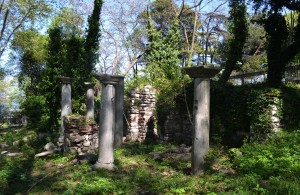
The Archaeological Museum isn't committing itself but seems to indicate that this is likely to be a church from the Orphanage of St Paul.

Posted June 19, 2014 Posted by Adam in Uncategorized
The Monastery of the Panaghia Hodegetria was built (probably in the early 5th Century) to hold an ikon of the Virgin and Child, said to have been painted by St. Luke the Evangelist. This was the symbol of Constantinople, an image thought to protect the city from all evil. It showed Mary standing and indicating the Christ Child as the way to salvation. This mosaic in the Chora is of this type. The name ‘Hodegetria’ means She who shows the way. The ikon appears to have been taken to The Church of St Saviour in Chora during the 1453 siege and subsequent conquest by the Ottoman forces. This is the last anyone saw of it. Inevitably, rumours of it resurfacing have been promulgated from time to time.
The Church of St. Mary Hodegetria was on the Pilgrims’ route in the latter part of the Byzantine Empire. Majeska (1984) cites reports of numerous Russian pilgrims and there were many others from various parts of Europe. However, they all leave descriptions of the ikon and not the church. The Spaniards Clavijo (who later had an audience with Timur) and, towards the end of the Empire, Pero Tafur described a ritual in which every Tuesday, the ikon would be paraded around the city by red-garbed monks. (van der Vin, 1980)
There’s not much of a chance of getting in here at the moment. Even the official archaeological projects don’t seem to be able to circumvent the difficulty of getting into a military zone. It is smack in the middle of where the soldiers won’t let you go when you try to walk downhill from Aya Ireni. Mamboury indicates that only the foundations of the ayazma remained in 1951. The crusaders of the 13th century were not kind to this church and the military are not renowned for their care of Christian ruins. There can’t be much there now. (41.009151,28.983371 – possibly)
Nicholas Artamonoff took some wonderful photographs of Istanbul in the 1930s and 1940s. This picture shows the large marble dodecagonal font over the ayazma at St Mary Hodegetria. Mamboury (1924) noted that the waters of the ayazma were supposed to restore sight and ascribed the name ‘Hodegetria’ to this attribute, rather than the presence of the ikon.
This capital is in the grounds of the Kalyon Hotel, close to the site of the Church of St Mary Hodegetria.
We may have access to the area at some time in the future as it appears that there are plans for the military zone to become a landscaped area more in keeping with the appearance of the rest of Saray Burnu.

Posted June 19, 2014 Posted by Adam in Uncategorized
The halting of train services from Sirkeci for work on the Marmaray means that in 2014 nobody really cares if you wander about on the railway track and hack about in the jungle below the walls of Topkapı Sarayı. If you break through the sea walls near the statue of Turgut Reis and head across the tracks, there is an exciting-looking building for those of us who enjoy scrabbling about in subterranean muck.
As of March 2016, the possibility of ad hoc exploration of this site has been reduced severely. The military has installed a businesslike razor-wire fence with watchtowers and alert guards on the western side of the railway line. No more little expeditions to this part of Istanbul for a while.
The vault is fairly intact and there is some above-ground brickwork. This may be the remains of the Church of St George of the Manganes (41.012171,28.986778).
The Palace of the Manganes is a little further west (41.010022,28.987159) and provides extensive remains for tunnelling and feeling intrepid. There are a few rather nice pieces of Byzantine stonework but the original alignment and relative positions of them have been lost through earth movements over the centuries.

Posted June 19, 2014 Posted by Adam in Uncategorized
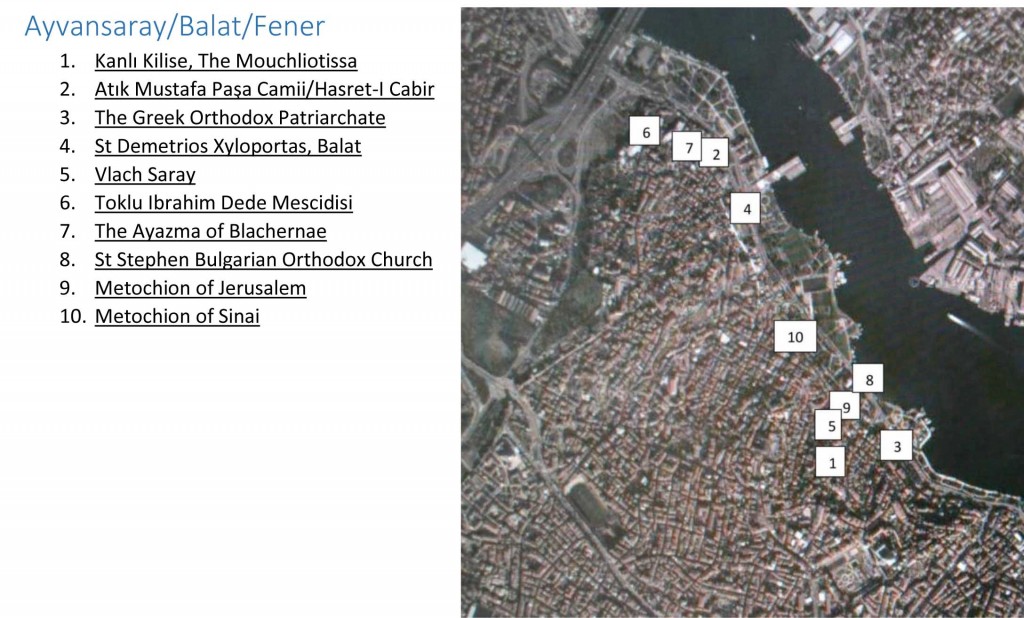

« Previous Entries Next Entries »
